COUPON – Save 30% off your entire order with code NAPLAB.
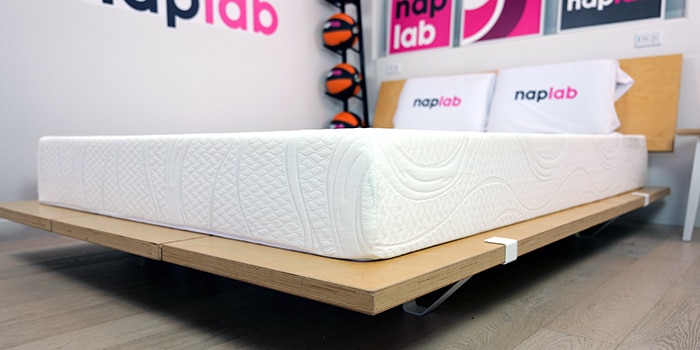
Best For
- Queen mattress under $500
- Fast material response time
- High bounce, good for sex performance
Considerations
- Cooling performance struggles with higher levels of heat retention
- Shorter 100-night trial period
- More motion transfer than average
Our Verdict
The Polysleep Sierra is a 9″ all-foam mattress made of poly foam and support foam. Currently, it is only available for purchase in Canada.
This mattress has minimal sinkage and a high level of bounce, making it a good option for back or stomach sleepers, although lightweight side sleepers may also enjoy it.
The Sierra comes in a single firmness (6 out of 10) with a medium-firm feel.
In our performance tests, the Sierra had lower performance than average as well as a price point that is 67% less than the average foam mattress.
If you’re looking for a super budget foam mattress, the Polysleep Sierra has some advantages, but performance is not one of them. If you have wiggle room in your budget, there are better options out there. For most sleepers, the slightly more expensive Polysleep Origin or Aura mattresses are going to be better options.
Type: Foam
Firmness: Medium-Firm (6)
Best For: All Sleeping Positions, Sleepers Under 200 lbs.
In This Review
Performance Tests | Firmness | Support & Sleeping Positions | Design | Materials | Comparisons | FAQs
Performance Tests
At NapLab, we put each mattress to the test.
We test 10 different factors that impact the performance, comfort, and value of the mattress. We then take the results of that test and compare to every mattress we’ve tested to date.
Check out the full performance table below to see how this mattress ranks:
| Factor | Polysleep Sierra | Average |
|---|---|---|
| Overall Score | 7.60 | 8.55 |
| Price (Queen) | C$483 | $1,089 (Foam only) |
| Cooling – Score | 7.0 | 8.7 |
| Sinkage – Depth | 1.81″ | 2.15″ |
| Sinkage – Feel | Minimal | Moderate |
| Motion Transfer – Score | 6.9 | 8.1 |
| Motion Transfer – Acceleration | 11.80 m/s² | 8.76 m/s² |
| Response Time – Score | 10 | 8.9 |
| Response Time – Mostly Recovered | 0.2 sec. | 0.4 sec. |
| Response Time – Fully Recovered | 0.3 sec. | 0.9 sec. |
| Bounce – Height | 10.38″ | 9.71″ |
| Bounce – Feel | High | Moderate |
| Edge Support – Score | 8.4 | 8.6 |
| Edge Support – Sitting | 3.25″ | 4.05″ |
| Edge Support – Lying | Fair | Good |
| Sex – Score | 9.0 | 8.5 |
| Pressure Relief – Score | 7.0 | 8.8 |
| Comfort Layer Thickness | 2.0″ | 4.1″ |
| Mattress Thickness | 9″ | 12.0″ |
| Off-Gassing – Score | 8.1 | 8.4 |
| Off-Gassing – Smell | Strong | Strong |
| Off-Gassing – Days | 7 days | 6 days |
| Company – Score | 6.2 | 8.8 |
| Trial | 100 nights | 168 nights |
| Warranty | 5 years | 24% have lifetime warranties, average of other 76% of mattresses is 13 years |
How is PolySleep Sierra Different?
The Polysleep Sierra is a 9″ foam mattress with below-average performance but also a price that is significantly below average as well—67% less expensive than the average foam mattress.
Advantages
Besides the below price, other advantages of the Sierra include fast material response time and better sex performance.
Neutral Factors
This mattress also has minimal sinkage and high bounce. Both bounce and sinkage are more preferential factors but may be an advantage or disadvantage for some sleepers.
Disadvantages
This mattress has more disadvantages that outnumber the advantages for many. Disadvantages include worse cooling performance, higher levels of motion transfer (35% more than average), and slightly worse edge support (20% worse than average). It also has a thinner comfort layer and worse pressure relief.
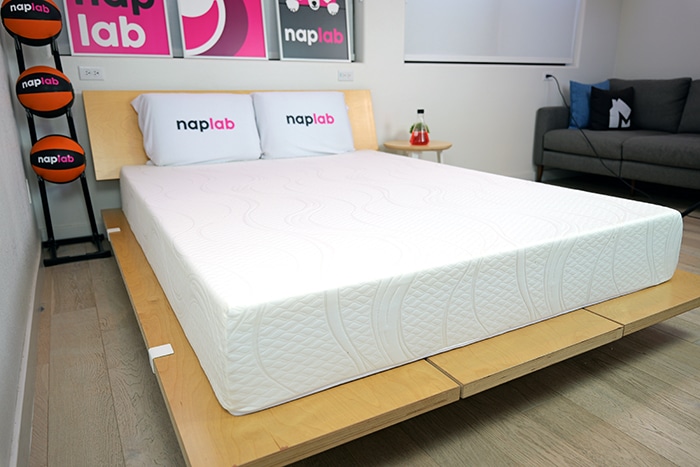
Company disadvantages include a shorter trial period and shorter warranty as well.
Cooling Test
The Polysleep Sierra has a fair level of cooling performance. During our tests, I felt a moderate level of heat retention around my body.
Baseline Temp.
79.6° F
Max Temp.
91.6° F
Ending Temp.
85.6° F
The mattress is an all-foam design, uses relatively basic poly foams, and has no substantial cooling features. As a result, there is only so much you should expect out of cooling performance. To be fair, it’s also incredibly budget-friendly.
Mattresses at this price point, especially all foam mattresses, generally don’t get much better than this for cooling.
Max Temp.
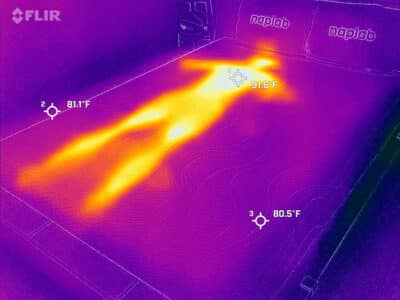
Ending Temp
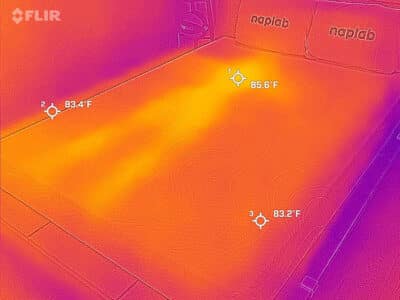
- Baseline Temperature – the temperature of the mattress before anyone lies on it
- Maximum Temperature (0 minute) – the temperature of the mattress after lying on it for 15 minutes
- Ending Temperature (5 minute) – the temperature of the mattress after being lied upon and having no one on it for 5 minutes
In our objective temperature testing, we measured a max surface level temperature of 91.6°F. This is 2.0° warmer than the average. After getting off the mattress from minutes 0 to 1 the temperature declined 4.4°, which is 0.3° warmer than average. The 0 to 5-minute decline was 6.0°, which is 1.3° warmer than average.
Heat Dissipation Over Time
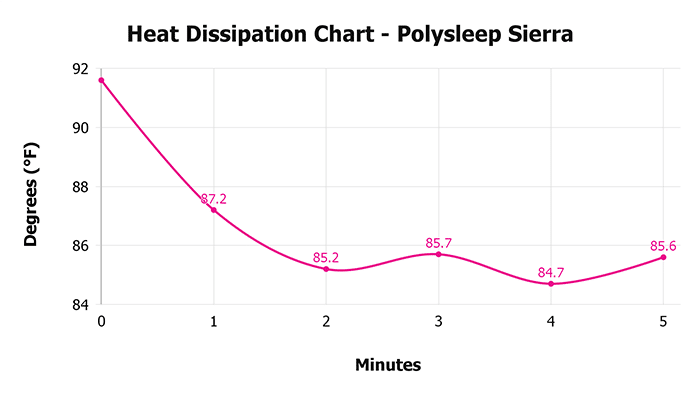
When we consider the objective data, subjective experience, and materials used, this is a mattress capable of delivering only a fair level of cooling performance.
Sinkage Test
The Polysleep Sierra has a minimal level of sinkage. In our sinkage tests, we measured a pressure point sinkage depth of 1.81”. This is 0.34” less sinkage than the average of 2.15”.
Sinkage Depth
1.81″
Sinkage Feel
Minimal
Body Contour
Balanced
The mattress creates more of a “floating” feeling as opposed to sinking down “in” the mattress.
The level of sinkage is documented in the image below.
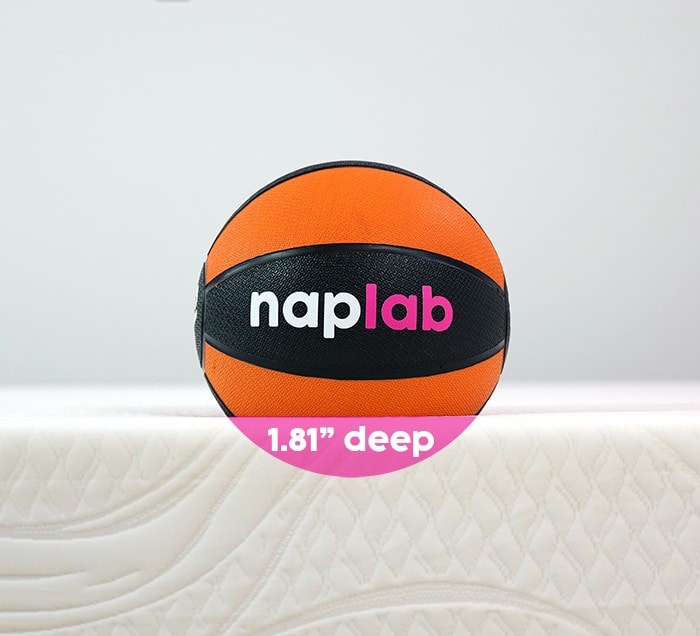
With only 2.0” of comfort material there is only so far down the mattress is able to sink and contour the body before you hit the support foam, which more firmly resists and floats the body.
At just 9.0” thick this is pretty typical performance for an all foam mattress.
Motion Transfer Test
The Polysleep Sierra has a high level of motion transfer. In our tests, we measured an acceleration range of 11.80 m/s². This is 36% more motion than the average of 8.68 m/s².
Accel. Range
11.80 m/s²
Motion Duration
0.82 seconds
Typically, all foam mattresses do a better job at reducing motion. However, thinner mattresses and mattresses with a thinner comfort layer create more motion transfer. So while the all-foam design is helping, the relative thinness of the total profile and comfort layer are negatively impacting motion.
The level of motion transfer is also documented in the video below.
In our motion transfer chart, which visualizes our accelerometer data, we can see the highest motion peaks from 0 to 0.15 seconds.
There is a small secondary spike from 0.45 to 0.52 seconds and by 0.82 seconds we’ve returned to near-zero levels of energy. While the initial motion spike is quite high, the level of motion following the spike is well restrained.
Motion Transfer Over Time
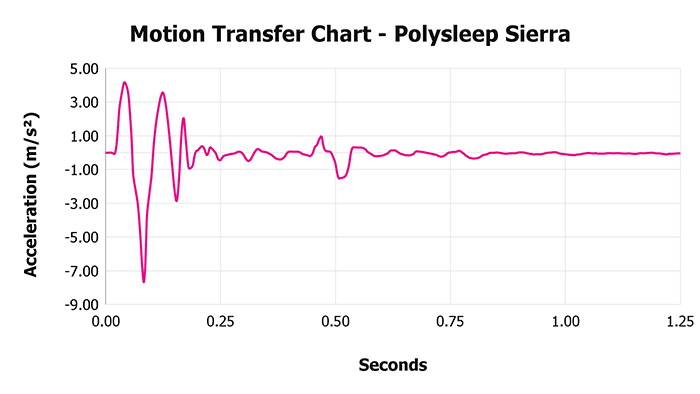
This is a mattress where more sensitive sleepers will likely find the motion is just too much. However, many other sleepers will find it acceptable.
Response Test
The Polysleep Sierra has an extremely fast material response time. In our tests, we measured a mostly recovered response time of 0.2 seconds. This is 51% faster than the average of 0.41 seconds.
Mostly Recovered
0.2 sec.
Complete Recovery
0.3 sec.
The level of responsiveness is documented in the video below.
In our fully recovered test, we measured a recovery speed of 0.3 seconds, which is 66% faster than the average of 0.89 seconds.
This is effectively an instant material responsiveness and is tied first with a number of other mattresses. The rapid responsiveness ensures you’ll never feel stuck on the mattress.
Bounce Test
The Polysleep Sierra has a high level of bounce. In our tests, we measured a total bounce height of 10.38”. This is 0.68” more bounce than the average of 9.70”.
Max. Depth
5.25″
Max. Rebound
5.13″
Total Bounce
10.38″
Max. Sinkage Depth
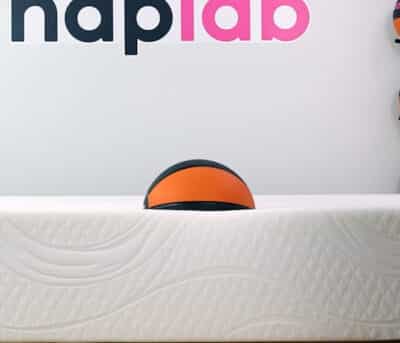
Max Bounce Height
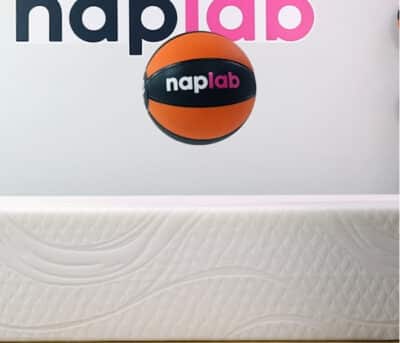
The level of bounce is also documented in the video below.
Typically, all foam mattresses don’t have much bounce. However, the thin total profile, thin comfort layer, and minimal level of sinkage are all working together to create more rebound and bounce on the mattress.
While the Sierra isn’t as high as many hybrid and coil-based mattresses, it’s no slouch when it comes to bounce. Higher bounce improves sex bounce and makes it easier to move around on the mattress.
Edge Support Test
The Polysleep Sierra has excellent sitting edge support and fair lying edge support. In our sitting edge support test, we measured a sitting sinkage compression of 3.25”. This is 0.80” sinkage less than the average of 4.05”.
Max. Sinkage
3.25″
Lying Support
Fair
Reinforced Edge
No
While sitting on the edge of the mattress the Sierra did a nice job of remaining supportive and retaining its shape. That said, lying edge support left something to be desired.
The level of edge support while seated is documented in the images below.
Sitting, 140 lbs.
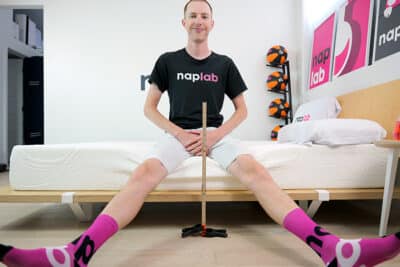
Sitting, 200 lbs.
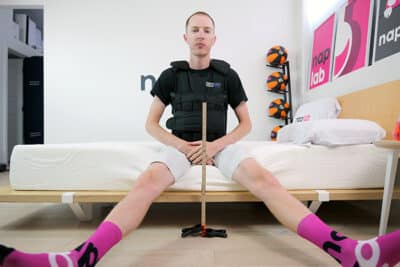
While lying directly on the edge of the mattress I did not feel well supported. I needed to move a couple of inches away from the absolute edge to again feel well-supported.
The level of edge support while lying is documented in the images below.
Lying on Edge, 140 lbs.

Lying on Edge, 200 lbs.
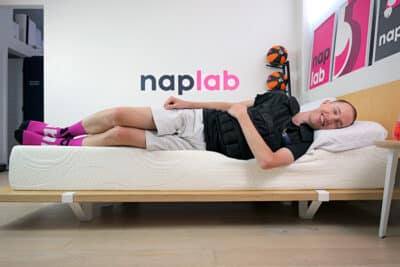
Given the price point, 9.0” design, all foam construction, and absence of any type of reinforced edge support foam, this performance is perfectly reasonable and expected.
Sex Test
The Polysleep Sierra has excellent sex performance. The Sierra nails the two primary factors you need for great sex, high bounce and great sitting edge support.
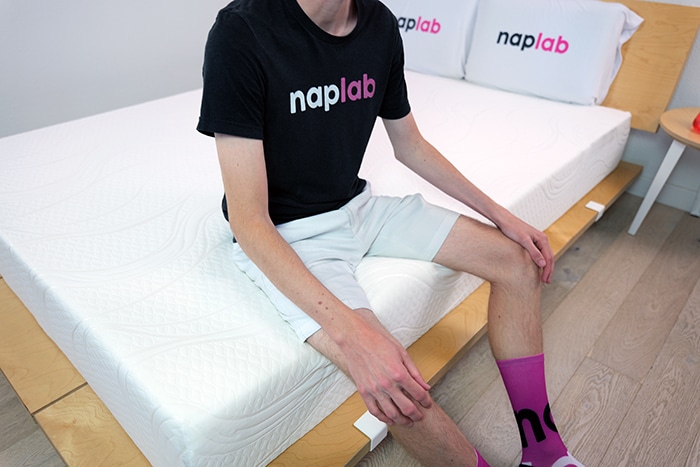
In addition, the mattress is quiet. The only minor detractors for sex are pressure relief and cooling, both of which have a fair level of performance, but also leave much to be desired.
As with many other performance aspects of the Sierra it’s hard to complain too much given the price point. Yes, it’s not perfect, but it’s more than serviceable and what you’d expect at this price.
| Sex Factor | Factor Weight | Score | Rating |
|---|---|---|---|
| Bounce | 65% | 9.0 | Very High |
| Edge Support | 20% | 9.7 | Excellent |
| Noise | 5% | 10 | Minimal |
| Pressure Relief | 5% | 7.0 | Fair |
| Cooling | 5% | 7.0 | Fair |
Pressure Relief Test
The Polysleep Sierra has a fair level of pressure relief performance. During our tests, I felt a moderate level of building pressure on my body, especially my lower back. Ultimately, this is a very inexpensive, budget-friendly mattress.
Comfort Layer
2.0″
Support Layer
7.0″
At just C$483 for a Queen, they just don’t have much money to equip the Sierra with sufficiently thick foam to deliver better levels of pressure relief.
The mattress uses a 2.0” comfort layer, which is 2.1” thinner than the average comfort layer thickness, which is 4.1” (based on all of our tests to date).
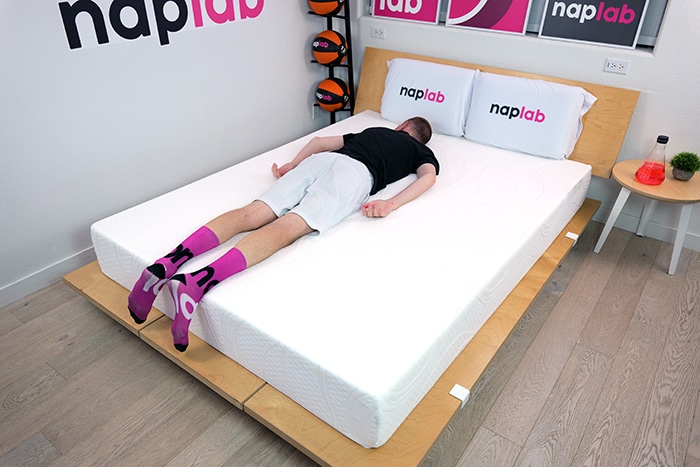
This thin comfort layer means your body comes into greater contact with the support foam, which in turn creates the pressure points. For lighter-weight bodies, kids, and guest rooms, this level of pressure relief is likely to be sufficient.
However, for most adults seeking a primary mattress, I would strongly recommend the step up to the Polysleep Origin or PolySleep Aura, both of which have notably better pressure relief performance.
Pressure Map – Side Sleepers

| Pressure Relief (PSI) | Average | Minimum | Maximum |
|---|---|---|---|
| Side Sleepers | 0.29 | 0.02 | 1.30 |
Pressure Map – Back Sleepers
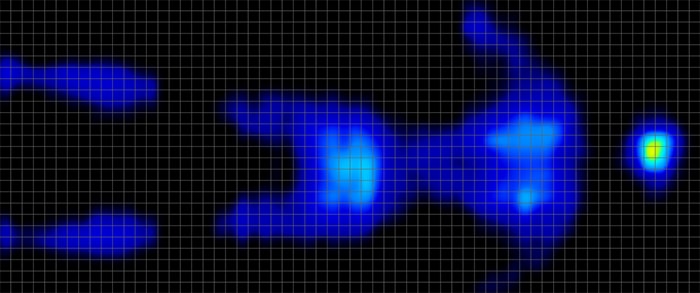
| Pressure Relief (PSI) | Average | Minimum | Maximum |
|---|---|---|---|
| Back Sleepers | 0.18 | 0.02 | 1.33 |
Pressure Map – Stomach Sleepers

| Pressure Relief (PSI) | Average | Minimum | Maximum |
|---|---|---|---|
| Stomach Sleepers | 0.15 | 0.02 | 1.08 |
Off-Gassing Test
Off-gassing on the Polysleep Sierra is strong right out of the box and takes 7 days for the smell to dissipate.
Initial Smell Strength
Strong
Off-Gassing Period
7 days
Company
Polysleep mattresses are made in Canada with mattresses being sold in US and Canadian markets (mattress models available by country). All mattresses come with a 100-night trial period, a 5-year warranty, and free shipping.
At any point in your trial, if you decide this mattress isn’t the right pick for you, you can exchange or return it for a full refund (minus a $90 return fee).
| Company Factor | Factor Weight | Score | Data |
|---|---|---|---|
| Returns | 40% | 7.0 | $90 |
| Trial Period | 30% | 8.0 | 100 nights |
| Warranty | 20% | 0 | 5 years |
| Shipping | 10% | 10 | $0 |
| Country of Origin | 0% | Canada |
Compared to average company policies, the Polysleep has a shorter trial period and shorter warranty than average. For reference, the average trial period is 166 nights and the average warranty is 14 years (26% of all mattresses have lifetime warranties).
Polysleep’s 5 year warranty is perhaps the most disappointing. Out of the 226 mattresses we’ve tested to date only 3 have had a warranty of less than 10 years. And 2 of those 3 are Polysleep mattresses. The industry norm is 10 years or more. I really would like to see Polysleep step up to the 10-year warranty mark for all of their mattresses.
How firm is Polysleep Sierra?
The Polysleep Sierra is a 9″ all-foam mattress with a medium-firm feel. It is a 6 out of 10 on the firmness scale, where 10 is the most firm. This firmness is generally suitable for a wide range of sleepers in all positions and varying weights.

Support & Sleeping Positions
The Polysleep Sierra has a fair level of support. During our tests, I felt well-supported. However, I also felt moderate pressure points on my body. The Sierra’s support problem is really more of a pressure relief problem.
| Support Factor | Data |
|---|---|
| Comfort Layer | 2.0″ |
| Support Layer | 7.0″ |
| Firmness | Medium-Firm |
| Body Contour | Balanced |
| Zoned Support | No |
| Reinforced Edge | No |
With only 2.0” of comfort materials, many sleepers, especially side sleepers, are more likely to sink through the comfort layer and come into greater contact with the support foam layer.
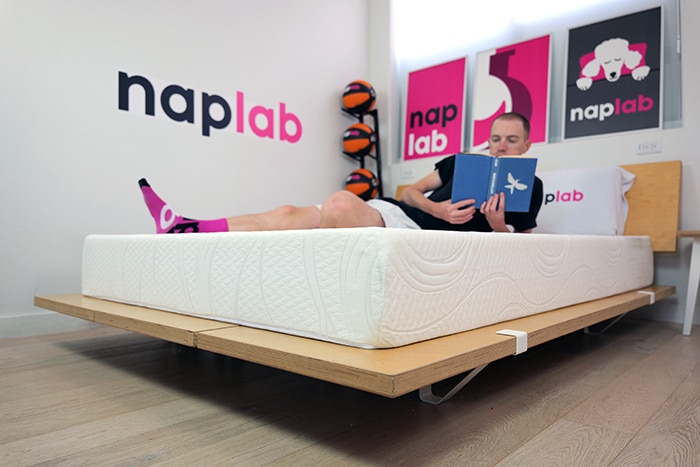
The support foam layer just isn’t especially comfortable and only having 2.0” of comfort material means sleepers will really feel that layer. This will create spinal alignment sleepers for many.
Check out the table below to see the sleeper weights and sleeping positions that would be best suited for this mattress.
| Sleeper Weight | Stomach Sleepers | Side Sleepers | Back Sleepers |
|---|---|---|---|
| Under 150 lbs. | Yes | Yes | Yes |
| 150-250 lbs. | Maybe | Maybe | Maybe |
| 250-300 lbs. | No | No | No |
Design
The Polysleep Sierra is a 9″ foam mattress with a medium-firm feel. It is designed as a base-level mattress, providing a budget-friendly option for Canadian sleepers looking for an all-foam mattress.
| Design Factor | Data |
|---|---|
| Type | Foam |
| Thickness | 9″ |
| Cover Type | Thin |
| Weight | 62 lbs. |
| Has Handles | No |
| Fiberglass-Free | Yes |
| Ships in a Box | Yes |
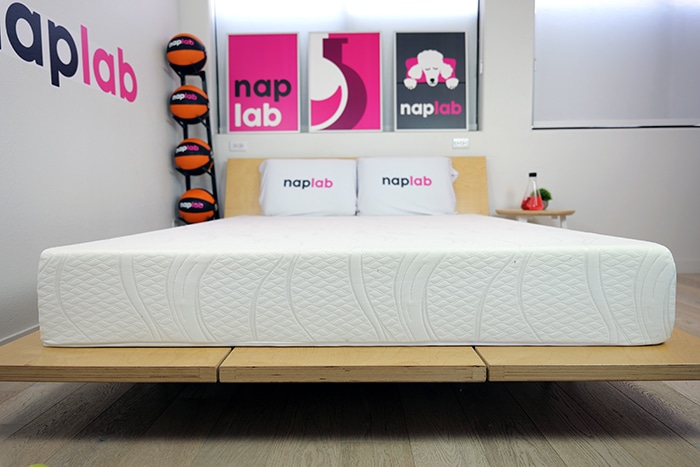
While you certainly do sacrifice some areas of performance, the price point is especially compelling.
Materials
This mattress has a very simple 2-layer design. Layers include:
| Layer Type | Thickness | Layer Specs |
|---|---|---|
| Poly Foam | 2.0″ | 3.0 PCF |
| Support Foam | 2.0″ | 1.4-1.5 PCF |
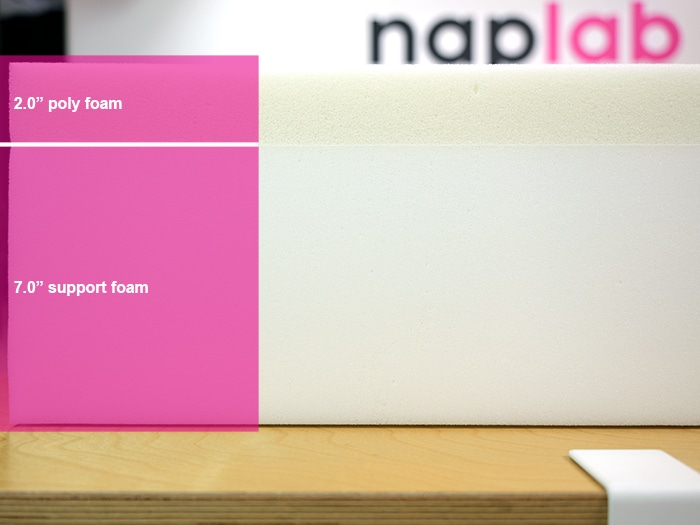
The Law Tag outlines the full breakdown of materials included in this mattress.
- Materials
- 100% Polyurethane Foam
- Cover
- 100% Polyester
- Approximate Finished Size 152.4 cm x 203.2 cm x 22.8 cm, 60 in x 80 in x 9 in
- Made in Canada
The Cover
The Polysleep Sierra has a 100% polyester cover that is thin, soft, stretchy, and removable. There is a zipper closure that allows the cover to easily be washed or spot-cleaned.
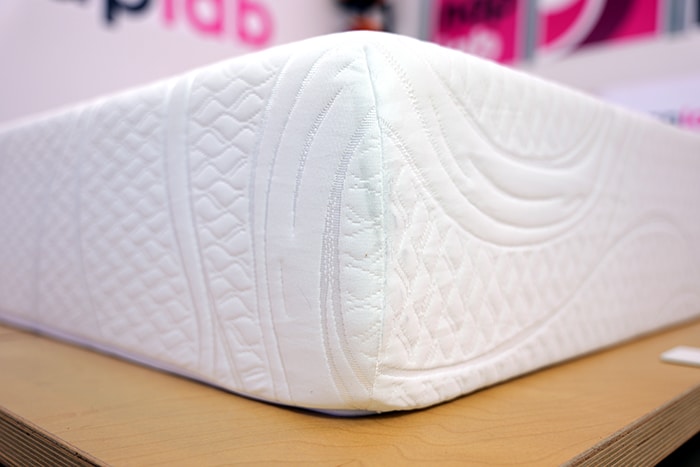
The Comfort Layer
The comfort layer of the Sierra is a relatively thin 2.0″ poly foam. There’s nothing inherently special about this comfort layer. It is simple and provides a balanced feel.
This comfort layer has a foam density of 3.0 lbs / ft3 (PCF).
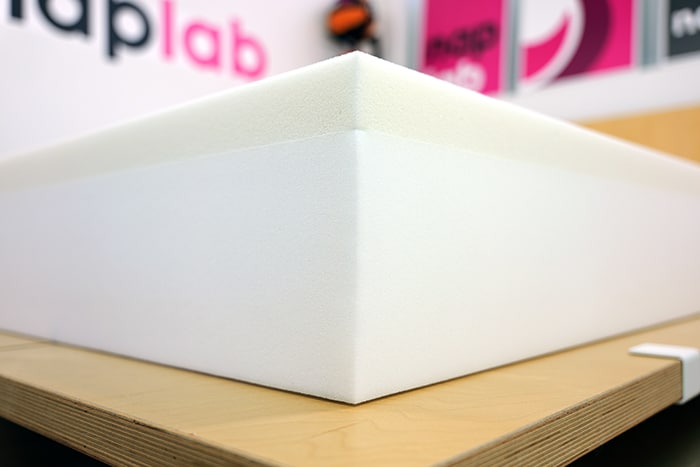
As mentioned above, heavier sleepers will likely find this support to be inadequate, as 4″ or more of comfort material is usually preferred.
The Support Layer
The Sierra support layer is a 7.0″ high-density support foam. This layer supports the comfort layer above. This layer has a foam density of 1.5 lbs / ft3.
For an all-foam mattress, this is about what we’d expect to see.
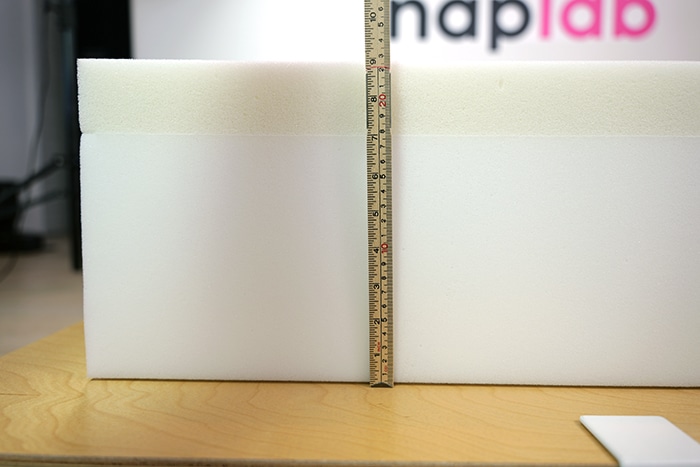
Product Evolution
The Polysleep Sierra mattress was released in 2023 as the “most affordable antimicrobial foam mattress made in Canada”. Since its release, there have been no major design changes made to this mattress.
Other Mattresses to Consider
Not sure if the Polysleep Sierra is the right pick for you? Check out these three other top-rated foam mattresses for high-performing alternatives you may want to consider.
For Performance

Douglas Original
Medium-Firm Feel
The Douglas Original is a 10″ foam mattress with a medium-firm feel (6 out of 10). It outperforms the Sierra in 7 out of 8 testing categories. The only category where Sierra was better is for fast material response time. But the Douglas offers a 365-night trial which may be better for some sleepers.
For Value
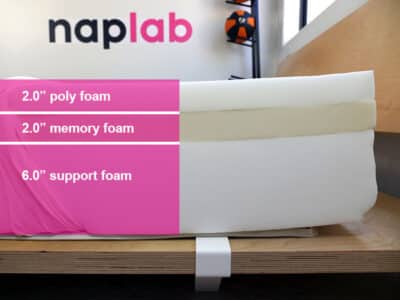
Leesa Original
4.0″ Comfort Layer
The Leesa Original is not made in Canada, but it does ship to Canada for free. Unlike the Sierra which has only a 2″ comfort layer, the Leesa combines a 2″ poly foam with a 2″ memory foam for 4″ of dynamic comfort. This gives the Leesa a better pressure relief score and lower levels of motion transfer as well.
For Pressure Relief
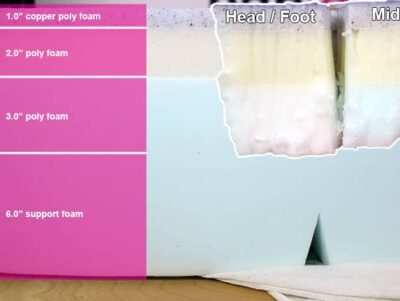
Polysleep Zephyr
Multi-Zoned System
The Polysleep Zephyr is definitely more expensive than the Sierra ($2,545 for a queen), but also offers some big advantages. This mattress is 12″ thick and has an advanced zoned pressure relief system. Cooling and motion transfer are also better on the Zephyr.
Frequently Asked Questions
Still have questions? Check out some of the top FAQs on the Polysleep Sierra mattress below and get the answers you’re looking for.
Here are the current prices, with any sales or promotions reflected below:
Twin: $406
Twin XL: N/A
Full: $452
Queen: $483
King: $550
Cal. King: N/A
*Note: Sales prices are subject to change without notice or warning.



